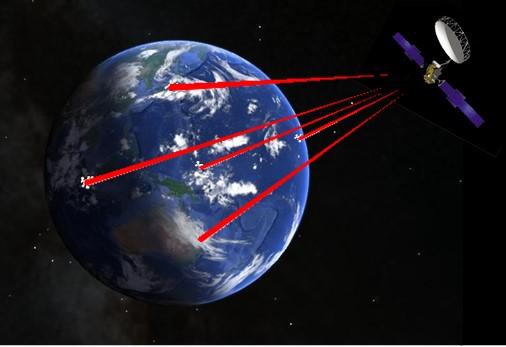Scientists Uncover Expedited Route to Establish Satellite-Based Quantum Encryption Network
In a recent study, scientists showcase the measurement of quantum states sent by a laser aboard a satellite positioned 38,000 kilometers above Earth from ground-based facilities. This marks the first instance of meticulously measuring quantum states over such a considerable distance.
Christoph Marquardt from the Max Planck Institute for the Science of Light in Germany expressed surprise at the robust survival of quantum states through atmospheric turbulence during transmission to a ground station. He highlighted that the study demonstrates the feasibility of utilizing satellite technology, already proven resilient against stringent environmental tests in space, for achieving quantum-limited measurements.
This breakthrough opens the door to the potential realization of a satellite-based quantum communication network, significantly reducing development time. The optimistic projection suggests that such a system could become a reality within the next five years. The establishment of a satellite-based quantum encryption network holds the promise of providing an exceptionally secure means of encrypting data transmitted across extensive distances.
Achieving this within a five-year timeframe is notably rapid, considering the usual decade-long development cycle for most satellites. Typically, every component, ranging from computers to screws, undergoes rigorous testing and approval to ensure functionality in the harsh conditions of space and withstands the gravitational stresses encountered during launch. The findings of Marquardt and colleagues from the division of Gerd Leuchs at the Max Planck Institute in Erlangen are detailed in their recent research published in Optica, The Optical Society’s journal for high-impact research.

Using light to keep data safe
Currently, various forms of communication, including text messages, banking transactions, and health information, rely on encryption techniques grounded in mathematical algorithms. The effectiveness of this approach lies in the formidable challenge of deciphering the specific algorithm used for encrypting a given piece of data. Nonetheless, experts anticipate the availability of computers with sufficient power to break these encryption codes within the next 10 to 20 years.
In response to this impending security threat, there has been a heightened focus on implementing more robust encryption methods, such as quantum key distribution. Unlike traditional methods relying on mathematical processes, quantum key distribution utilizes the properties of light particles, known as quantum states, to encode and transmit the key necessary for decrypting secured data.
If an attempt is made to measure the light particles in order to steal the key, it alters the particles’ behavior, alerting the intended communicating parties to the compromise of the key, rendering it unusable. The ability of this system to detect eavesdropping ensures the guarantee of secure communication. While quantum encryption methods have been under development for over a decade, their application over long distances has been hindered.
Residual light losses in the optical fibers used for ground-based telecommunications networks degrade the delicate quantum signals, and quantum signals cannot be regenerated without altering their properties, as is done for classical optical data using optical amplifiers. Consequently, there is a recent push to establish a satellite-based quantum communication network, connecting ground-based quantum encryption networks across different metropolitan areas, countries, and continents. The recent findings indicate that quantum communication satellite networks don’t need to be created from scratch. However, Christoph Marquardt notes that the conversion of ground-based systems to quantum-based encryption, enabling the communication of quantum states with satellites, is expected to take 5 to 10 years.
Measuring quantum states
In conducting the experiments, Marquardt’s team collaborated closely with satellite telecommunications company Tesat-Spacecom GmbH and the German Space Administration. Tesat-Spacecom had previously received a contract from the German Ministry of Economics and Energy, via the German Space Administration, to develop optical communications technology for satellites.
This technology is currently in commercial use in space through laser communication terminals onboard Copernicus—the European Union’s Earth Observation Programme—and the SpaceDataHighway, the European data relay satellite system. Interestingly, the satellite optical communications technology employed by Tesat-Spacecom closely resembled the quantum key distribution method developed at the Max Planck Institute.
This led the researchers to explore the feasibility of measuring quantum states encoded in a laser beam transmitted from an existing satellite in space. In 2015 and the early part of 2016, the team conducted these measurements from a ground-based station at the Teide Observatory in Tenerife, Spain. Quantum states were generated in a frequency range not typically used by the satellite, enabling the team to perform quantum-limited measurements from the ground. Marquardt expressed surprise at the system’s adaptability for operating as a quantum key distribution network, given that it was not originally designed for this purpose.
The researchers were impressed with the optimization efforts undertaken by the engineers involved in the project. Currently, the team is collaborating with Tesat-Spacecom and other entities in the space industry to develop an upgraded system based on the existing hardware deployed in space. This involves enhancements to the laser communication design, the inclusion of a quantum-based random number generator for generating random keys, and the integration of post-processing for the keys. Marquardt emphasized the substantial interest from the space industry and other organizations in implementing their scientific findings. As fundamental scientists, the team is actively collaborating with engineers to create an optimal system, ensuring meticulous attention to detail throughout the process.
This article is republished from PhysORG under a Creative Commons license. Read the original article.
Do not forget to share your opinion with us to provide you with the best posts !




0 Comments